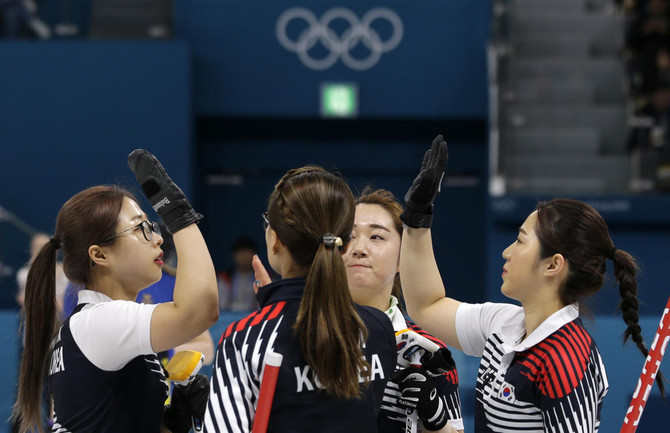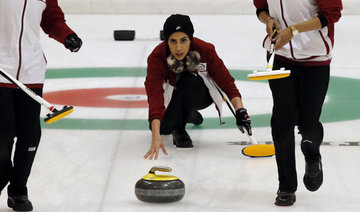GANGNEUNG, South Korea: Forget Lindsey Vonn and Adam Rippon. The real rock stars of the Pyeongchang Olympics are a humble group of Korean curlers who have no idea they’ve become a global sensation.
They are known as the “Garlic Girls,” the South Korean women’s curling team with the fairy-tale story whose moniker reflects the locally-famed garlic grown in their hometown. Never considered a medal contender coming into Pyeongchang, they have risen to No. 1 in the rankings, earning worldwide attention for their fierce talent and funny personalities.
And yet the Garlic Girls have been almost totally sheltered from the international frenzy both by personal choice — they switched off their phones during the games to block outside attention — and by a protective coach who is keenly aware that curling is as much a mental game as a physical one.
After a recent match, the women were quickly shuffled past waiting reporters, giving journalists apologetic smiles and greetings of “Anyonghaseyo!” (hello) before vanishing. None of them, says coach Kim Min-jung, are aware that they’ve become superstars.
“I’m sorry that I could not bring the athletes today, because I’m worried there will be too much pressure and burden on them,” Kim said. “Even the crowd is too interested in them.”
That interest is understandable. The Garlic Girls seem tailor-made for stardom.
The wildly skilled underdogs came into the Olympics ranked eighth in the world and went on to crush curling heavyweights including Canada and Sweden. They are cute and comical, referring to themselves by quirky nicknames such as “Pancake” and “Steak.”
Two teammates are sisters and all are longtime friends, creating irresistible chemistry on the ice. The team’s “skip,” or captain, has a steely gaze and funky, owl-eyed glasses that have become fodder for endless Internet memes.
Many Koreans who have never seen a curling match have nonetheless traveled to remote Gangneung to peek at their nation’s new darlings in person.
“I’m very proud of them,” said Lee Ji Sun, a 26-year-old who had never been inside a curling arena before Wednesday’s match. “They are showing we can do well even in new sport events.”
Every match featuring the team is packed with screaming, flag-fluttering Koreans who leap to their feet to cheer on the women’s stunningly precise shots. One fan in the crowd Wednesday waved what appeared to be a hand-drawn portrait of skip Kim Eun-jung with her trademark spectacles.
The excitement surrounding the women even prompted a few dozen senior citizens from the southern city of Jaecheon to charter a bus to the arena so they could revel in the country’s newfound curling prestige.
“I actually don’t know curling rules, so I have to find out what’s going on from people sitting next to me,” said Yang Chang-nam, 77. “I feel very good as the South Korean team is doing well.”
That curling has gained any prominence in Korea is surprising in itself. Korea didn’t even have a team in Olympic curling until the 2014 Sochi Games.
It took Koreans awhile to wake up to curling, largely because the country lacked sufficient facilities until recent years, Kim Young, a curling legend who started the Korean Curling Club in 1988, said by email. Now, he says, Korea has six dedicated curling arenas, and many schools have curling teams.
In 2006, South Korea’s first curling center was built in the rural town of Uiseong. Four of the five team members attended Uiseong Women’s High School, where they were on the school’s curling team. Uiseong’s reputation as the nation’s default curling capital slowly grew, and the curling center has hosted about 15 major domestic and international curling events.
Still, until the women’s team began their surprise winning streak in Pyeongchang, Uiseong was better known for its prolific garlic production.
Koreans consider garlic a health food that boosts stamina. Seo Eun Ha, a 26-year-old Garlic Girls fan, believes garlic may have contributed to the team’s success. (She also credits the women’s good teamwork and strong relationships.)
Like many fans at Gangneung, Seo is particularly fond of the curlers’ unusual nicknames: Sunny, Steak, Pancake, Annie (a brand of yogurt) and ChoCho (a type of cookie).
“I think their nicknames go well with their lively images,” Seo said. “I like ‘Steak’ the most. It sounds so funny and unique.”
The nicknames started as a gag over breakfast one day, said Kim, the coach. The women were talking about how difficult it was for other countries’ athletes to pronounce their names at international competitions. All five team members and their coach also share the same surname — Kim, which is very common in Korea — making their names even more confounding for foreigners.
Kim Seon-yeong, who was eating a sunny-side-up fried egg, joked that she could go by the name “Sunny.” The other women loved the idea. They each opted to nickname themselves after the English words for their favorite breakfast foods, figuring that would be easier for others to grasp.
Though the women’s team is getting the most attention, Korean fans have been going wild for the men, too. After Wednesday’s men’s match, a player from the Korean team began throwing T-shirts into the crowd, which surged forward with outstretched arms.
Kim Heae Darm, a fan who leaped up and managed to snag a shirt sailing overhead, pressed it to her face and screamed with glee. She then turned to capturing the attention of Korean mixed doubles player Lee Ki-jeong, who scrawled his autograph in her notebook.
As she struggled to catch her breath, she explained her excitement by noting that Lee was strong, athletic and “very handsome.”
“I like them so much!” she squealed.
Kim believes the exposure the sport has received in Pyeongchang will lead to an influx of new curlers in the country, particularly because parents will support children taking it up.
As for the success of the women’s team, Kim, the founder of the curling club, couldn’t be prouder. “They are heroes!” he said.
Yet the Garlic Girls do have one request: Maybe someone could come up with a nicer team name for them?
“We would prefer the name ‘Team Kim,’” Kim, the coach, said with a laugh. “Because although our hometown is Uiseong — which is related to garlic — we have no relationship with garlic at all.”
Garlic Girls: South Korean curlers the rock stars of Winter Olympics
Garlic Girls: South Korean curlers the rock stars of Winter Olympics

A 98-year-old in Ukraine walked miles to safety from Russians, with slippers and a cane

- Describing her journey, the nonagenarian said she had fallen twice and was forced to stop to rest at some points, even sleeping along the way before waking up and continuing her journey
KYIV, Ukraine: A 98-year-old woman in Ukraine who escaped Russian-occupied territory by walking almost 10 kilometers (6 miles) alone, wearing a pair of slippers and supported by a cane has been reunited with her family days after they were separated while fleeing to safety.
Lidia Stepanivna Lomikovska and her family decided to leave the frontline town of Ocheretyne, in the eastern Donetsk region, last week after Russian troops entered it and fighting intensified.
Russians have been advancing in the area, pounding Kyiv’s depleted, ammunition-deprived forces with artillery, drones and bombs.
“I woke up surrounded by shooting all around — so scary,” Lomikovska said in a video interview posted by the National Police of Donetsk region.
In the chaos of the departure, Lomikovska became separated from her son and two daughters-in-law, including one, Olha Lomikovska, injured by shrapnel days earlier. The younger family members took to back routes, but Lydia wanted to stay on the main road.
With a cane in one hand and steadying herself using a splintered piece of wood in the other, the pensioner walked all day without food and water to reach Ukrainian lines.
Describing her journey, the nonagenarian said she had fallen twice and was forced to stop to rest at some points, even sleeping along the way before waking up and continuing her journey.
“Once I lost balance and fell into weeds. I fell asleep … a little, and continued walking. And then, for the second time, again, I fell. But then I got up and thought to myself: “I need to keep walking, bit by bit,’” Lomikovska said.
Pavlo Diachenko, acting spokesman for the National Police of Ukraine in the Donetsk region, said Lomikovska was saved when Ukrainian soldiers spotted her walking along the road in the evening. They handed her over to the “White Angels,” a police group that evacuates citizens living on the front line, who then took her to a shelter for evacuees and contacted her relatives.
“I survived that war,’ she said referring to World War II. “I had to go through this war too, and in the end, I am left with nothing.
“That war wasn’t like this one. I saw that war. Not a single house burned down. But now – everything is on fire,” she said to her rescuer.
In the latest twist to the story, the chief executive of one of Ukraine’s largest banks announced on his Telegram channel Tuesday that the bank would purchase a house for the pensioner.
“Monobank will buy Lydia Stepanivna a house and she will surely live in it until the moment when this abomination disappears from our land,” Oleh Horokhovskyi said.
Amazon Purr-rime: Cat accidentally shipped to online retailer

- Galena was found safe by a warehouse worker at an Amazon center after vanishing from her home in Utah
LOS ANGELES: A curious cat that sneaked into an open box was shipped across the United States to an Amazon warehouse after its unknowing owners sealed it inside.
Carrie Clark’s pet, Galena, vanished from her Utah home on April 10, sparking a furious search that involved plastering “missing” posters around the neighborhood.
But a week later, a vet hundreds of miles (kilometers) away in Los Angeles got in touch to say the cat had been discovered in a box — alongside several pairs of boots — by a warehouse worker at an Amazon center.
“I ran to tell my husband that Galena was found and we broke down upon realizing that she must have jumped into an oversized box that we shipped out the previous Wednesday,” Clark told KSL TV in Salt Lake City.
“The box was a ‘try before you buy,’ and filled with steel-toed work boots.”
Clark and her husband jetted to Los Angeles, where they discovered Amazon employee Brandy Hunter had rescued Galena — a little hungry and thirsty after six days in a cardboard box, but otherwise unharmed.
“I could tell she belonged to someone by the way she was behaving,” said Hunter, according to Amazon.
“I took her home that night and went to the vet the next day to have her checked for a microchip, and the rest is history.”
What did people eat before agriculture? New study offers insight

- Analysis of forms — or isotopes — of elements including carbon, nitrogen, zinc, sulfur and strontium in these remains indicated the type and amount of plants and meat they ate
WASHINGTON: The advent of agriculture roughly 11,500 years ago in the Middle East was a milestone for humankind — a revolution in diet and lifestyle that moved beyond the way hunter-gatherers had existed since Homo sapiens arose more than 300,000 years ago in Africa.
While the scarcity of well-preserved human remains from the period preceding this turning point has made the diet of pre-agricultural people a bit of a mystery, new research is now providing insight into this question. Scientists reconstructed the dietary practices of one such culture from North Africa, surprisingly documenting a heavily plant-based diet.
The researchers examined chemical signatures in bones and teeth from the remains of seven people, as well as various isolated teeth, from about 15,000 years ago found in a cave outside the village of Taforalt in northeastern Morocco. The people were part of what is called the Iberomaurusian culture.
Analysis of forms — or isotopes — of elements including carbon, nitrogen, zinc, sulfur and strontium in these remains indicated the type and amount of plants and meat they ate. Found at the site were remains from different edible wild plants including sweet acorns, pine nuts, pistachio, oats and legumes called pulses. The main prey, based on bones discovered at the cave, was a species called Barbary sheep.
“The prevailing notion has been that hunter-gatherers’ diets were primarily composed of animal proteins. However, the evidence from Taforalt demonstrates that plants constituted a big part of the hunter-gatherers’ menu,” said Zineb Moubtahij, a doctoral student in archaeology at the Max Planck Institute for Evolutionary Anthropology in Germany and lead author of the study published on Monday in the journal Nature Ecology & Evolution.
“It is important as it suggests that possibly several populations in the world already started to include substantial amount of plants in their diet” in the period before agriculture was developed, added archeogeochemist and study co-author Klervia Jaouen of the French research agency CNRS.
The Iberomaurusians were hunter-gatherers who inhabited parts of Morocco and Libya from around 25,000 to 11,000 years ago. Evidence indicates the cave served as a living space and burial site.
These people used the cave for significant portions of each year, suggesting a lifestyle more sedentary than simply roaming the landscape searching for resources, the researchers said. They exploited wild plants that ripened at different seasons of the year, while their dental cavities illustrated a reliance on starchy botanical species.
Edible plants may have been stored by the hunter-gatherers year-round to guard against seasonal shortages of prey and ensure a regular food supply, the researchers said.
These people ate only wild plants, the researchers found. The Iberomaurusians never developed agriculture, which came relatively late to North Africa.
“Interestingly, our findings showed minimal evidence of seafood or freshwater food consumption among these ancient groups. Additionally, it seems that these humans may have introduced wild plants into the diets of their infants at an earlier stage than previously believed,” Moubtahij said.
“Specifically, we focused on the transition from breastfeeding to solid foods in infants. Breast milk has a unique isotopic signature, distinct from the isotopic composition of solid foods typically consumed by adults.”
Two infants were among the seven people whose remains were studied. By comparing the chemical composition of an infant’s tooth, formed during the breastfeeding period, with the composition of bone tissue, which reflects the diet shortly before death, the researchers discerned changes in the baby’s diet over time. The evidence indicated the introduction of solid foods at around the age of 12 months, with babies weaned earlier than expected for a pre-agricultural society.
North Africa is a key region for studying Homo sapiens evolution and dispersal out of Africa.
“Understanding why some hunter-gatherer groups transitioned to agriculture while others did not can provide valuable insights into the drivers of agricultural innovation and the factors that influenced human societies’ decisions to adopt new subsistence strategies,” Moubtahij said.
Palestinian prisoner in Israel wins top fiction prize

- The mask in the novel’s title refers to the blue identity card that Nur, an archaeologist living in a refugee camp in Ramallah, finds in the pocket of an old coat belonging to an Israeli
ABU DHABI: Palestinian writer Basim Khandaqji, jailed 20 years ago in Israel, won a prestigious prize for Arabic fiction on Sunday for his novel “A Mask, the Color of the Sky.”
The award of the 2024 International Prize for Arabic Fiction was announced at a ceremony in Abu Dhabi.
The prize was accepted on Khandaqji’s behalf by Rana Idriss, owner of Dar Al-Adab, the book’s Lebanon-based publisher.
Khandaqji was born in the Israeli-occupied West Bank city of Nablus in 1983, and wrote short stories until his arrest in 2004 at the age of 21.
He was convicted and jailed on charges relating to a deadly bombing in Tel Aviv, and completed his university education from inside jail via the Internet.
The mask in the novel’s title refers to the blue identity card that Nur, an archaeologist living in a refugee camp in Ramallah, finds in the pocket of an old coat belonging to an Israeli.
Khandaqji’s book was chosen from 133 works submitted to the competition.
Nabil Suleiman, who chaired the jury, said the novel “dissects a complex, bitter reality of family fragmentation, displacement, genocide, and racism.”
Since being jailed Khandaqji has written poetry collections including “Rituals of the First Time” and “The Breath of a Nocturnal Poem.”
He has also written three earlier novels.
Mexican doctor claims victory in $28 Cartier earrings battle

MEXICO CITY: A Mexican man has claimed a victory over French luxury brand Cartier, saying an error allowed him to buy two pairs of earrings for $28 that were supposed to cost nearly $28,000.
After a four-month struggle, doctor Rogelio Villarreal said he had finally received the jewelry, which he accused the company of refusing to deliver after his online purchase in December.
According to Villarreal, he came across the low-priced earrings while browsing Instagram.
“I swear I broke out in a cold sweat,” he wrote on the social media platform X.
Cartier declined to recognize the purchase and offered Villarreal a refund, as well as a bottle of champagne and a passport holder as compensation, according to a company letter shared by the doctor.
But Villarreal refused and decided to take the case to Mexico’s consumer protection agency, which ruled in favor of the doctor.
Cartier accepted the decision, Villarreal announced.
“War is over. Cartier is complying,” he wrote.


















